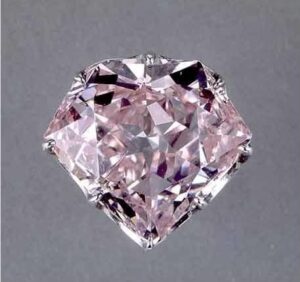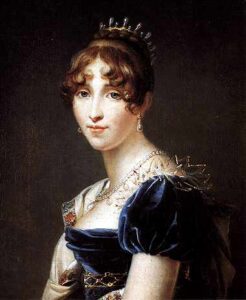
It seems each famous diamond has some kind of mystery attached to it, usually involving the location of its discovery, the identity of the discoverer, or a contested ownership. With the Hortensia diamond, the mystery lies in its name. Not as in who it was named after – that honor belongs to a Frenchwoman named Hortense de Beauharnais, who was destined to become Queen of Holland. Rather, the mystery is why it was named after her. Usually, the naming of a famous gemstone is done because that person has some sort of direct history with it. Yet, in this case, the diamond’s namesake had limited or no access to the stone, never owned it, never wore it, and never was married to someone who owned it. The best connection that can be made is that she was both the sister-in-law and stepdaughter of the owner. Yet the stone bears her name. Since recorded history sheds little light on solving this mystery, it leaves one open to drawing one’s own conclusions.
Weighing in at 20.53 carats, the Hortensia Diamond is a flat, light pink diamond with a five-sided outline that is marred by a feather (very fine crack) that runs from the girdle (outer edge) to the culet. History records French King Louis XIV as an owner, where, according to a 1691 inventory list of the French Crown Jewels, its first appearance was in a floret of buttonholes. Later settings included a mounting for Napoleon’s epaulet braid and in 1856 as the centerpiece of a headband for Empress Eugénie.

The diamond’s namesake, Hortense de Beauharnais, was born in Paris, France, the daughter of Alexandre, Vicomte de Beauharnais and Marie Rose Josèphe Tascher de la Pagerie. When the marriage didn’t work out, Marie Rose was divorced by her husband and she – along with Hortense – was sent to a convent. With the finalization of the divorce, Marie Rose returned to Martinique with her young daughter to live with her impoverished parents. Meanwhile, Hortense’s father would not survive the French Revolution, dying by guillotine during the infamous “Reign of Terror.”
After years of growing up in exile on the Island of Martinique, Hortense and her mother finally returned to Paris. Successfully working her way back into French society, now known as Joséphine, she remarried this time to no less than the famed general and future Emperor of France, Napoleon Bonaparte. Now the step-daughter of the famous French leader, Hortense enjoyed the perks of being part of the most powerful family in France, including being educated alongside the likes of Napoleon’s sister and the daughter of future United States President James Monroe.
When it came time for Hortense to marry, she was matched with Napoleon’s brother, Louis Bonaparte. Shortly after being crowned Emperor and as part of his quest to consolidate all of Europe under his rule, Napoleon appointed his brother King of Holland, making Hortense the country’s queen in 1806. Although their marriage was not a happy one, Hortense accompanied Louis to The Hague to assume her new duties. Still, there is no mention of Hortense’s connection to the diamond that bears her name.
Over the years Hortense had to weather many personal storms… an extremely jealous husband, the death of her eldest son, claims of infidelity attached to the birth of her third son (later to be known as Napoleon III), and actual infidelity resulting in a fourth son that she freely admitted was not sired by Louis. During the return of the monarchy in France and Napoleon’s exile to Elba, Hortense and Louis divorced. Later, she dabbled unsuccessfully in politics, supporting Napoleon following his escape from Elba and return to power. Her punishment for supporting Napoleon during the Hundred Days was banishment from France. Now roaming the continent, she eventually settled in Arenenberg, Switzerland in 1817, where she lived until her death in 1837.
It was surely sometime during this period (1806-1817) that the diamond was named after her. Yet there is nothing to document when or why it happened. Perhaps it was done when she became Napoleon’s step-daughter, or when she married Napoleon’s brother, or when she became the Queen of Holland, or maybe it was during Napoleon’s return from exile to show Hortense his gratitude for her support. Could Napoleon and Hortense have been secret lovers? The truth is we may never know.
What we do know is that the diamond was stolen twice. The first time was in 1792 when, during the French Revolution, the Garde Meuble (Royal Treasury) was stormed by rioters who made off with most of the Crown jewels – including the Hortensia and the Regent. Sadly, much of what was taken was never recovered. Among the lost items were the Royal French Blue (now believed to have been re-cut to become the Hope Diamond) and the Sancy Diamond. But the fate of the Hortensia was to take a different path. Thanks to the last-minute confession of a condemned man by the name of Depeyron, the Hortensia, along with the Regent and some other items, was recovered, found hidden in a Garret in the Halles district of Paris. The second time it was stolen was in 1830 from the Ministry of the Marine – but the Hortensia did not remain at large for very long.
Today the remaining French Crown Jewels are on display in Paris at the Galerie d’Apollon of the Louvre Museum. Included – in this much-diminished collection – are Louis XV’s coronation crown, Napoleon’s coronation crown, Eugénie’s tiara from 1853, a crown from 1855 along with a diamond and sapphire parure worn by Marie-Amelie (1782-1866), wife of Louis-Philippe, the Regent, and Sancy diamonds. Also on display is the Hortensia, still begging the question of all who come to view it – why was it named for someone with no recorded association to the stone?
Sources
- Balfour, Ian. Famous Diamonds, London: Christie, Manson & Woods Ltd., 2000. Pp. 136-137.
- Khalidi, Omar. Romance of the Golconda Diamonds, Middletown New Jersey: Mapin Publishing Pvt. Ltd., 1999. Pp. 71
- Royal Jewelry – Jewellery and Treasure of Royals and Aristocracy. Imperial Jewels – Les joyaux de la couronne de France: Butschal, © 2007. http://www.royal-magazin.de/french/crown-jewels.htm
- Answers.com. Answers Corporation, © 2008. http://www.answers.com/topic/hortense-de-beauharnais
- Includes the following:
- Eugénie- Hortense de Beauharnais: Britannica Concise Encyclopedia. Britannica Concise Encyclopedia. © 2006 Encyclopædia Britannica, Inc. All rights reserved.
- Beuharnais, Hortense de: Columbia Encyclopedia. The Columbia Electronic Encyclopedia, Sixth Edition Copyright © 2003, Columbia University Press. Licensed from Columbia University Press. All rights reserved. www.cc.columbia.edu/cu/cup/
- Hortense de Beauharnais: Wikipedia. This article is licensed under the GNU Free Documentation License. It uses material from the Wikipedia article “Hortense de Beauharnais”.